Are you planning to buy a new soldering system, equipment, or robot for printed circuit board assembly in your manufacturing unit? Here is a quick look at recent features—just what you want to know before investing.
The electronics industry is advancing rapidly in technology, and automation is taking the lead in manufacturing spaces. Automating the soldering process is found to be a more efficient alternative to hand soldering, with the latest technologies and soldering accessories in place. However, there are significant applications that still need hand soldering, and hand soldering stations are not going to go out anytime soon. So, you need to consider the best-in-the-class in both automated and hand soldering, before making the right choice to help you save costs, improve quality and productivity, and ensure standard safety practices.
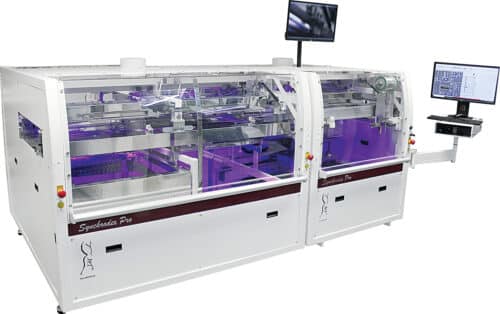
Trendy features in recent launches
The recent machines and soldering stations have undergone incremental improvements from the previous generation models with more focus to provide manufacturers with efficient temperature and power control, and motion flexibility.
Capability to handle large PCBs
The industry is handling large printed circuit boards (PCBs) that are used in supercomputers and servers with complex miniature components. Hence the recent launches have more focus on the maximum size of printed circuit boards that can be soldered in the machine.
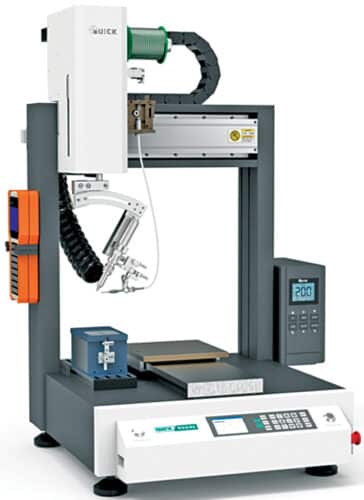
According to Bittele Electronics, a PCB assembly house headquartered in Canada, the largest panel size available is 14.50×1.37 metres, which can be fabricated for two-layer boards. The company can fabricate four-layer boards with maximum size of 0.55×1.35 metres. Manufacturers say that there will be additional fabrication cost for PCBs that have sides longer than 50.8 centimetres. For example, Pillarhouse Orissa Synchrodex Pro is a selective soldering system that can process PCBs up to 114.3×60.96 centimetres when using the XL frame size.
Combined systems
The most popular and best soldering equipment comes in integrated packages that are either fully or semi-automatic. Fully automatic are those with soldering modules or soldering robots, safety covers, conveyors, loaders, and unloaders, while semi-automatic are the soldering modules or robots which can be retrofitted into automatic packages to reduce the number of steps and make the process quick and eliminate the need for expensive carriers used in processes like wave soldering.
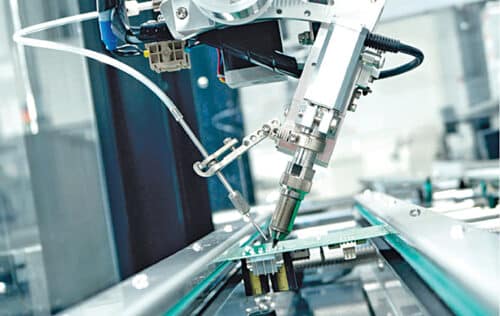
The REECO Soldering Robot is an example in which two or more robots can form cooperative assemblies and, for example, can work with other equipment, loader, and unloader stations. The robot uses programmable logic controller (PLC) system to control all auxiliary equipment, such as transport, soldering generator, wire feeder, and tip cleaning station.
Temperature and wattage control
Temperature control is one of the most important factors in soldering systems to avoid faulty soldering. Wattage is a parameter to indicate how rapidly the heating element can raise the tip temperature.
An iron rated at 25 watts may take over a minute to bring the tip temperature up to 660°F (about 349 degrees centigrade) from room temperature and the one rated at 130 watts will get there in a couple of seconds. Moreover, when the hot tip transfers heat to the cooler PCB pad and component leads, it can become colder. Hence the heating element is used to maintain tip temperature. Lower wattage soldering irons cannot replenish the heat lost and may lead to defective soldering. So, it is advisable to select stations equipped with minimum 60 watts heating power.
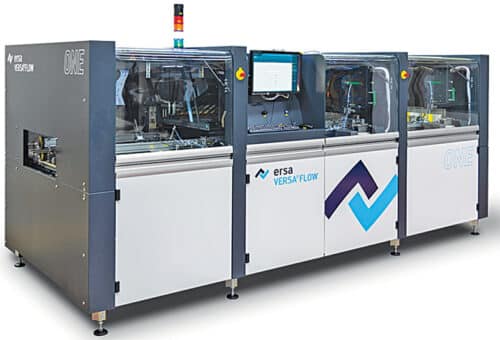
In contrast to the popular belief, the high-wattage iron will not destroy delicate components. A temperature-controlled soldering iron is designed to switch off the heater when the tip reaches a preset temperature. A powerful heating system will only ensure quick thermal recovery during soldering. The soldering station with 130 watts of heating power will not be of much use if the tip is allowed to get cold before the heating element kicks in.
So, remember to choose stations with closed-loop temperature control. A digital closed-loop temperature control system comes with a heating element, temperature sensor, and also a microprocessor control unit. It is a common feature to prevent both temperature undershoot and overshoot while soldering.
The Hakko FX-951 is a relatively more modern station with direct heat soldering technology that not only allows it to react faster to thermal changes but also maintain tip temperature. The tip in such stations is a composite design available as a unified package with heating element and thermocouple to avoid thermal drift.
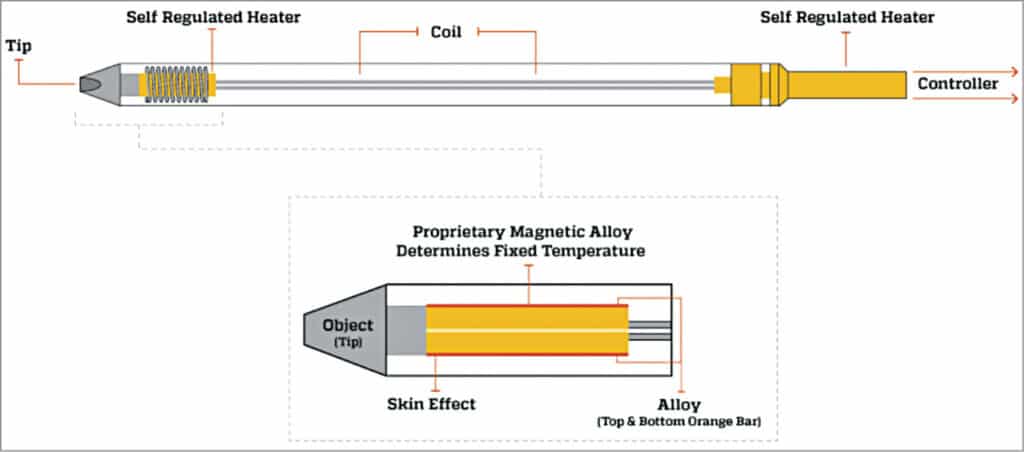
In the automated lines, QUICK ET9484E Soldering Robot is a new launch that features a robust hot iron system with a superior closed-loop temperature sensing feedback. Two fine-toothed gears work to pull solder from the solder spool. It then perforates the solder wire, allowing better out gassing of flux core, resulting in less solder ball and flux splatter defects.
Ersa’s VERSAFLOW ONE is another model with improved heating in the cross profile, which significantly reduces machine’s power requirements.
Heat technology
Induction soldering is a process where two or more metals are joined together by melting and flowing a filler metal (solder) into the joint interface. It does not involve melting of the joints. This often gives a bit weaker joint compared to a brazed one but is a desirable result for many sensitive electronics or small components. Curie Heat Technology is where the iron tips respond to the thermal demands of each solder joint by adjusting the power instantaneously, thereby meeting the exact requirements of the substrate component and solder material.
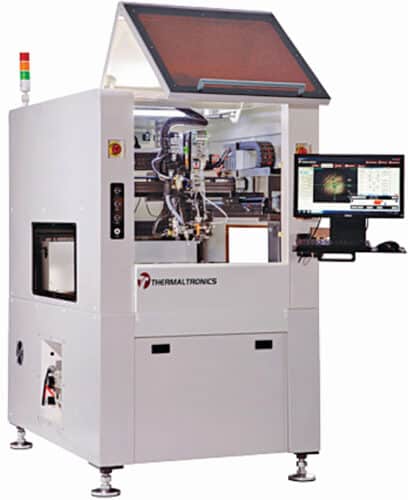
One of the most critical aspects in soldering is choosing the right solder tip, which helps to achieve uniform heating of component leads and pads on the PCB. Some soldering solutions, such as Metcal’s SmartHeat Technology, can be used with the necessary tips and cartridges to ensure proper soldering. The cartridge in here is made of a heater of proprietary design and has a non-heating copper core and an outer heating layer of magnetic alloy. The composition of the alloy predetermines the tip temperature, and it can self-regulate maintaining constant temperature (±1.1°C).
More axes
Traditional robotic soldering machines that feature linear motion in 3-axis and 4-axis type soldering robots are currently available in the market. In 3-axis, the soldering tip moves in 3 directions—X, Y and Z, with Z as the movement of the base plate. Similarly, in 4-axis type the tip moves in 3 directions—X,Y and Z, and in an angular momentum of the soldering tip. Here, the soldering tip can change its angle to match any angular surface on a PCB.
The 6-axis soldering works a bit differently from the 3-axis and 4-axis types. Conventionally, a solder wire is fed to the soldering tip to perform a solder joint on a PCB. However, as per the IPC soldering standards, the solder wire must be fed to the joint and not to the soldering tip. This type came up as a solution to comply with IPC standards where the robot has two independent mechanisms—one to feed the soldering wire to the joint directly and the other to solder on to the PCB.
The latest upgrade is the 8-axis soldering that works slightly differently from the other types, giving 360 degrees of freedom. This increases the capabilities of the robot to perform operations in fewer setups. Considering that each setup requires additional power, material, and time, fewer setups translate into cost-savings. Thermaltronics Inc’s TMT RS0099S is a model with 8-axis capability and 360° independent fixture rotation.
Laser soldering
Laser soldering is a non-contact process that eliminates the risk of marring or damaging sensitive components. This technique gives flexibility and is found to be suitable for mass production. As the system has a completely closed structure, it is free of pollution and ensures safety. It also provides process enhancements and zero consumable expenses.
The recent launches have various techniques that use different laser beam shapes like ring type or square type. It gives flexibility for manufacturers to choose the shape considering their board pattern and components to avoid burning sensitive parts. A few machines have also come up with beam-splitting technology providing twin-spot lasers to simultaneously solder two joints. Japan Unix Laser Soldering Equipment is among the recent launches featuring various patented laser beam shapes suitable for micro-soldering applications.
Micro-soldering
Some components used in a PCB board are smaller than the size of a grain and micro-soldering uses smaller tools to solder them. One can connect even small wires that are nine microns in size. Laser soldering systems are found to be effective for micro-soldering.
“A laser’s parameter is much smaller than even the finest soldering tip. It can reach spaces that are too narrow or inaccessible for an iron tip. As electronic parts become smaller and more intricate, this is becoming more relevant,” says Shailendra Mathur, business head at Maxim SMT Technologies.
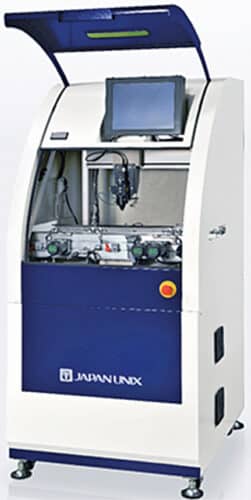
Advanced software
CAD/CAM software has become increasingly democratised, more affordable, and accessible. The recent software systems allow robots to be set up with minimal programming in a few steps. These software can be easily integrated with real-time analysis, model based definition (MBD) software, and 3D viewing systems, thereby enabling quality improvements with reduced chances of user errors.
Apollo Seiko’s L-CAT NEO-N is one of the soldering robots that allows reduction in cycle time and makes programming and setup much simpler. Robot teaching can be performed by the touch panel teaching pendant, a computer, or a tablet.
Dual port operating solder station
Since PCBs have different components, there is a need to use soldering tips of different shapes, sizes, and temperatures depending on the application. Even using a cartridge type tip may not be easy as it needs to be replaced to continue the soldering process. With recent advancements in technology, soldering stations give the convenience of getting two different tasks done with one station.
The dual port soldering station HAKKO FM-203 comes with another handpiece connected to the other port/channel which has temperature settings and tip shape installed.
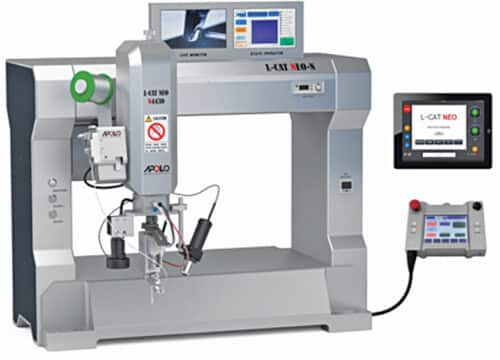
IoT solder station
The Internet of things (IoT) soldering station represents the latest evolution of the soldering station connected to the company network that enables full traceability for manual soldering. As soon as the soldering station is integrated into a company network, all mobile devices in the company network can access and communicate with the soldering stations via web browser. The server based communication concept makes it easier to manage individual soldering stations and makes the process documentable.

For instance, the i-CON TRACE is claimed to be the world’s first fully networkable soldering station with integrated wireless local area network (WLAN), Bluetooth, and network card.
The way forward: automation
Soldering becomes more precise and error-free when automated, and is ideal for soldering complex components onto PCBs for a variety of applications in the fields, including automotive, aviation, and telecommunications. The equipment comes as hi-tech integrated packages, while robots come with various features with sturdy construction design to give optimum performance. Both have similar features like high-resolution cameras to support soldering with real-time view, vision alignment, great temperature control, superior thermal feedback system, nitrogen systems, and many more for most challenging solders. Therefore, industry experts believe both robots and soldering equipment are ideal for the soldering process.
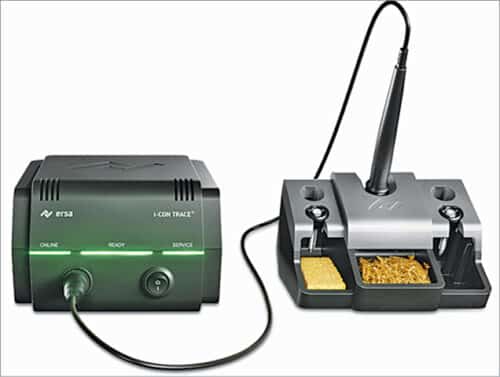
“Choosing a soldering equipment or robot is an application-driven query. There are different needs for PCBs coming to the manufacturers. For instance, if a board has more thermal demands, we look for machines with more pre-heating technologies, and if something has more small components, we look for the availability of micronozzle features. It is also important to consider the size of the mother boards, and selective soldering is a great solution to solder larger boards. However, manual soldering may not be advisable for miniatures used in IoT devices or auto-ancillary equipment,” says Arvind Gopal Joshi, director at Accurex Solutions, a sales and support provider of capital equipment used for pcba.
Joshi suggests looking at specific standards while planning automation. “The automated equipment launched in recent times are designed to meet standards like the IPC 2591 connected factory exchange (CFX),” he says.
According to the IPC global trade association, the IPC 2591 is the open industry standard that supports IPC-CFX. The standard applies to communication between all executable processes in the manufacture of printed board assemblies—automated, semiautomated, and manual—and is applicable to related mechanical assembly and transactional processes.
Despite the high initial expense in setting up both equipment or robots, over time automated soldering proves cost-effective compared to soldering by hand. By using automated machines, both the cost of labour and costs associated with the training and re-training of soldering experts is reduced. Additionally, the increased precision afforded by these machines can ensure better quality work that eliminates the need for rework. Investing in good quality parts and accessories further reduces costs over time.
The automated systems will be more prevalent in the future while they would still be working along with humans, assisting the experts to do their job more efficiently and effectively.
The author, Abbinaya Kuzhanthaivel, is a technology enthusiast






